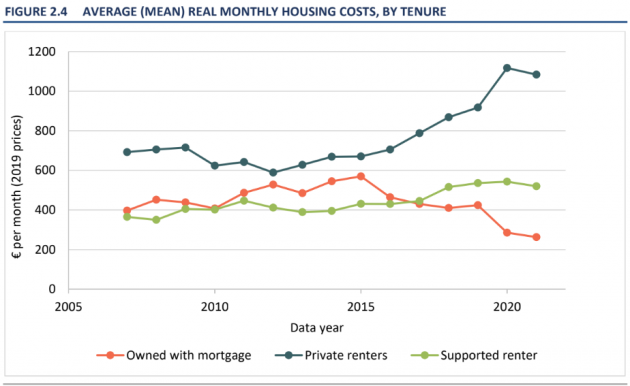The ESRI's second annual Poverty, Income Inequality and Living Standards in Ireland report, published today, shows that between 2012 and 2021 the average private rate in the state will rise from €589 to €1,084 per month.
For young and low-income private renters, home affordability has drastically decreased as a result of rising rents.
According to the study, for private renters in the lowest income bracket, the average housing cost to income ratio went from 0.226 to 0.304 between 2007 and 2021. This ratio calculates the median cost of a home divided by the median household income.
For private renters between the ages of 18 and 34, it climbed as well, from 0.116 to 0.221.
The gini coefficient, which gauges how money is distributed throughout society, has fallen by around a fifth since it peaked in 1987, according to the analysis.
According to the report's predictions, 785,000 people—or 15.6% of the population—were at risk of living in poverty in 2021 on an after-housing cost (AHC) basis.
On a before-housing-cost (BHC) basis, this compares to 12.4%, or 625,000 persons.
In 2021, the AHC at-risk of poverty rate for single parents and their kids was predicted to be 46%, or over 153,000 people.
However, it also predicts that, on an AHC basis, 69% of the 695,000 individuals experiencing material deprivation in 2021 had earnings over the poverty line. Material deprivation is defined as being unable to buy two or more items from a list of 11 needs.
After taking into consideration family size, over half of these individuals lived in a home where someone reported having a disability, with the majority of these individuals earning less than €100 per week or less than the poverty line.
According to the research, poverty risk remains higher for people living in families where someone reports having a disability. In contrast to 315,000 persons on an AHC basis, it was discovered that 267,000 people were at risk of poverty on a BHC basis last year.
According to the research, about 220,000 of the 625,000 individuals living below the BHC income poverty line and 333,000 of the 740,000 people living below the AHC income poverty line respectively reside in families with an adult of working age who is employed full-time.
This, it says, "reflects the fact that households with someone in paid labour make up the bulk of the working-age population, despite their significantly lower income poverty rates."
It also notes that renters and lone parents are disproportionately represented among the so-called "working poor."
Compared to just 5.5% and 28% of working households above the poverty line, respectively, a quarter of the working poor live in lone-parent households, and over half reside in private or assisted rental housing.
Paul Redmond, a report co-author, stated that because poverty is associated with a poorer level of well-being and social marginalisation, it is a cause for concern.
"In Ireland, in-work poverty impacted about 220,000 people in 2019. This was especially common among tenants who were supported and single parents. A person on the minimum wage was also disproportionately dependent on the working poor."
"However, because the majority of those at risk of poverty do not work, raising the minimum wage will have a limited influence on the overall reduction of poverty. This emphasises the need for other policies to combat poverty, like accessible, high-quality daycare to permit at least one adult in a household to work full-time.
The report's other author, Michelle Barrett, stated that it discovers that the official definition of poverty "possibly excludes many persons in households afflicted by a handicap."
This is because it fails to take into account the significant additional expenditures of living incurred by this group, which raises the possibility that the official poverty indicator's income-related component should be calculated differently.





.png)
The opinions posted here do not belong to 🔰www.indiansdaily.com. The author is solely responsible for the opinions.
As per the IT policy of the Central Government, insults against an individual, community, religion or country, defamatory and inflammatory remarks, obscene and vulgar language are punishable offenses. Legal action will be taken for such expressions of opinion.